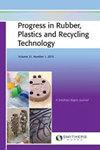Fungal mycelium-based biofoam composite: A review in growth, properties and application
IF 1.6
4区 材料科学
Q4 MATERIALS SCIENCE, COMPOSITES
Progress in Rubber Plastics and Recycling Technology
Pub Date : 2024-05-08
DOI:10.1177/14777606241252702
引用次数: 0
Abstract
Recent years have shown a surge in interest in incorporating living systems into materials research to synthesize functional materials using biological resources. Among these, mycelium-based materials, notably biofoam, have emerged as innovative solutions for repurposing organic wastes that were previously considered unusable. The growth of mycelium, vital for the synthesis of biofoam, is influenced by a multuple of factors including substrate composition, moisture content, temperature, nutrient availability, pH levels, oxygen concentration, and measures for contamination control. Additionally, physical stimulation techniques have been explored to enhance mycelium growth, ranging from cold stress-induced adaptations to electrical shock-induced modifications and optimization of sound treatments and light exposure. This review highlights the growing interest in biofoam composite materials, a novel class of environmentally friendly and cost-effective materials that are gaining popularity, for advancing sustainable construction practices. Biofoam composites use organic fungal growth as a low-energy bio-fabrication process to transform abundant agricultural byproducts and waste into viable alternatives to energy-intensive manufactured building materials. Their versatility in composition and manufacturing methods allows them to be used in a wide range of applications, including insulation and door cores, panelling, flooring, and furniture components. Notably, biofoams outperform synthetic foams and engineered wood in terms of thermal insulation, sound absorption, and fire resistance, making them highly promising for construction industry. Besides, due to its customizable composition and production method, biofoam can be used in the replacement of foams, leather, wood, and plastics in a variety of applications such as water treatment and filtration, medical supplies and healthcare applications. However, despite their remarkable properties, biofoam typically serve as non- or semi-structural supplements to traditional construction materials due to inherent limitations. Nevertheless, the useful material properties of these materials, combined with their low cost, ease of manufacture, and environmental sustainability, imply that they will have an important part to play in the development of environmentally friendly materials in the future.基于真菌菌丝的生物泡沫复合材料:生长、特性和应用综述
近年来,人们对将生物系统纳入材料研究,利用生物资源合成功能材料的兴趣日益高涨。其中,以菌丝体为基础的材料,特别是生物泡沫,已成为重新利用以前被认为不可用的有机废物的创新解决方案。菌丝体的生长对生物泡沫的合成至关重要,它受多种因素的影响,包括基质成分、含水量、温度、养分供应、pH 值、氧气浓度和污染控制措施。此外,人们还探索了物理刺激技术来促进菌丝生长,包括冷应激诱导的适应性、电击诱导的改变以及声音处理和光照的优化。生物泡沫复合材料是一类新型的环保材料,成本效益高,在推动可持续建筑实践方面越来越受欢迎。生物泡沫复合材料利用有机真菌生长作为一种低能耗的生物制造工艺,将丰富的农业副产品和废物转化为能源密集型人造建筑材料的可行替代品。生物泡沫塑料在成分和制造方法上的多样性使其可以广泛应用于各种领域,包括隔热材料、门芯、镶板、地板和家具部件。值得注意的是,生物泡沫塑料在隔热、吸音和防火方面优于合成泡沫塑料和人造木材,因此在建筑行业大有可为。此外,由于其成分和生产方法可定制,生物泡沫可用于替代泡沫、皮革、木材和塑料,广泛应用于水处理和过滤、医疗用品和保健等领域。然而,尽管生物泡沫具有非凡的特性,但由于其固有的局限性,生物泡沫通常只能作为传统建筑材料的非结构或半结构补充。然而,这些材料的有用材料特性,加上其低成本、易制造和环境可持续性,意味着它们将在未来环保材料的发展中发挥重要作用。
本文章由计算机程序翻译,如有差异,请以英文原文为准。
求助全文
约1分钟内获得全文
求助全文
来源期刊

Progress in Rubber Plastics and Recycling Technology
MATERIALS SCIENCE, COMPOSITES-POLYMER SCIENCE
CiteScore
4.40
自引率
7.70%
发文量
18
审稿时长
>12 weeks
期刊介绍:
The journal aims to bridge the gap between research and development and the practical and commercial applications of polymers in a wide range of uses. Current developments and likely future trends are reviewed across key areas of the polymer industry, together with existing and potential opportunities for the innovative use of plastic and rubber products.
 求助内容:
求助内容: 应助结果提醒方式:
应助结果提醒方式:


